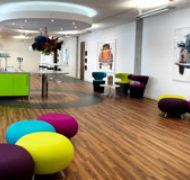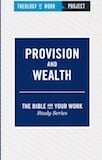Beauty Boosts the Bottom Line
Blog / Produced by The High Calling
I came late to a theory of the necessity of beauty. I'm a task-driven person who used to put my stainless steel pots on the table as a signal that dinner was served. It was a man who showed me the difference china and linens could make, to bring refreshment to what I treated as a functional daily ritual.
Likewise, it was a man who made the case for beauty, to office-furniture manufacturer Herman Miller, when it came time to build a new factory. Designer Bill McDonough and his team convinced the manufacturer to spend ten percent more than the cost for a standard metal prefab factory. Why? To ensure plenty of light, beautiful views, an indoor tree-lined "street," and an outdoor landscape that would invite indigenous species to linger near the site. (I am picturing Thumper and Bambi respectively.)
At one point, after construction, a less attractive competitor factory lured a number of workers away with higher wages. But the exodus was short-lived. Within a few weeks, beauty beckoned, and many of the workers returned to Herman Miller.
McDonough and Braungart tell this story in Cradle to Cradle: Remaking the Way We Make Things. They urge an attention to beauty— partly in the form of light, air, space, and living things (people exhibit something called "biophilia," which to my mind is a love of God's Creation), noting that the effect is both aesthetic and economic.
At Herman Miller's beautiful factory, dramatic increases in productivity and impressive retention rates make the case. Accordingly, the authors remind businesses...
Securing and supporting a talented and productive workforce is one of a CFO's primary goals, because the carrying cost of people— recruiting, employing, and retaining them— is a hundred times as great as the carrying cost of the average building.
Many businesses and organizations are beyond the stage of designing beauty into their building structures. Still, there are plenty of ways to offer a little "linens and china"— to boost the bottom line, and keep the people who keep it strong.
Bringing Beauty In
1. Consider the issue of beauty in your work setting. What kind of setting makes you more productive? Less? Are there steps you can take to bring beauty into your personal work space? (Beauty comes in many forms. Think about sound, fragrance, spatial arrangement, visual decor, natural and living things.)
2. What challenges do you face regarding bringing beauty to your workplace? Consider how you might creatively meet these challenges.
3. If the beauty of a work setting affects the bottom line, can businesses afford to ignore it? How can an organization determine when a critical beauty-point has been reached? What can help organizations decide how much resources to assign to the issue?
4. At TheHighCalling, we try to support you in your daily life and work. How can we help bring beauty to these arenas?
Image by Oliver Butler. Used with permission via Flickr. Post by L.L. Barkat, author of God in the Yard: Spiritual Practice for the Rest of Us.
“Most of the material on The High Calling is available for reuse under a Creative Commons 3.0 license. Unfortunately, work by Laura Barkat is not available for reuse. If you are interested in reprinting work by Laura Barkat, please contact her directly.”





